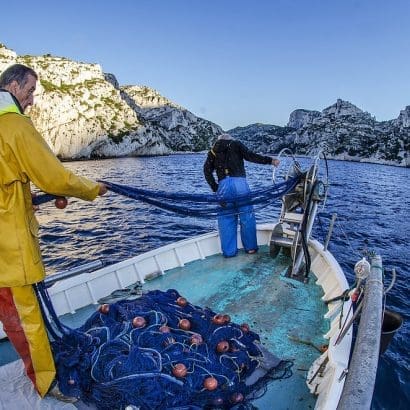
Oceanic whirlpools, also known as marine eddies, are fascinating and powerful natural phenomena that occur in the world’s oceans. These phenomena can vary in size and duration, and their formation is due to a combination of complex and varied factors. Throughout this article, we will explore in detail how these oceanic whirlpools form, what factors contribute to their appearance, and why they are so important to marine ecosystems.
Contents
What is an Oceanic Whirlpool?
Definition and Characteristics
An oceanic whirlpool is a rotating current of water that forms in the ocean. These whirlpools can range from small and temporary to large and permanent. Generally, the largest and most enduring whirlpools are found in the Atlantic and Pacific Oceans. The distinguishing characteristics of a whirlpool include its rotating motion, the speed of the water, and the exchange of nutrients and marine organisms that occurs within it.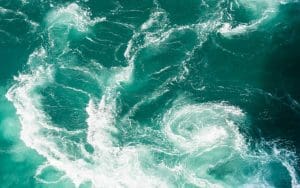
Historical Context and Notable Examples
Historically, whirlpools have been mentioned in various cultures and mythologies. For example, the Charybdis in Greek mythology was a sea monster later rationalized as a giant whirlpool. In more recent times, large whirlpools such as the Moskstraumen near Norway and the Old Sow in the Bay of Fundy have become points of interest for scientists and sailors alike.
Factors Contributing to the Formation of Oceanic Whirlpools
Ocean Currents
One of the main factors in the formation of whirlpools is the interaction of ocean currents. Surface currents, driven by wind and differences in temperature and salinity, can converge and diverge, creating vortices of water. Additionally, deep currents also play a crucial role by interacting with surface currents.
To understand how oceanic whirlpools can impact fishing activities, we invite you to read our article on small-scale fisheries and their importance to the local economy.
Winds and Storms
Besides currents, winds and storms can trigger the formation of whirlpools. Strong and consistent winds can push large masses of water in specific directions, generating spins and eddies. Tropical storms and hurricanes can also create temporary whirlpools by disturbing the upper layers of the ocean.
Earth’s Rotation and the Coriolis Effect
The Earth’s rotation causes the Coriolis effect, which deflects moving objects to the right in the northern hemisphere and to the left in the southern hemisphere. This deflection is crucial in the formation of whirlpools, as it contributes to the circular motion of water masses.
Temperature and Salinity Gradients
The differences in temperature and salinity between water masses can also lead to the formation of whirlpools. Warmer, saltier water tends to rise and move, while cooler, fresher water sinks and can create downward currents. When these different water masses meet, the interaction can result in spinning motions and eddy formations.
Topographical Features
Underwater topography, such as seamounts, ridges, and valleys, can influence the formation of whirlpools. These features can direct and channel water currents in ways that promote circular motion. For instance, water flowing over an underwater ridge can accelerate and create a vortex as it descends the other side.
Mechanisms of Formation
Coriolis Force
The Coriolis force, caused by the Earth’s rotation, is fundamental in the formation of oceanic whirlpools. This force deflects water currents to the right in the northern hemisphere and to the left in the southern hemisphere. As a result, moving masses of water begin to spin, forming whirlpools.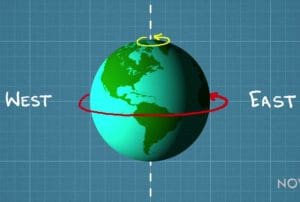
Interaction of Water Masses
Another important mechanism is the interaction between different water masses with varying temperatures and salinities. When these water masses meet, they can create spins due to density differences. This phenomenon is particularly common in convergence zones, where warm and cold currents meet.
Discover the best practices for pairing your fresh catches with selected wines in our article on fish and wine combination for a unique culinary experience.
Wind Stress and Ekman Transport
Wind stress on the ocean surface can induce a spiral effect in the upper layers of the ocean. Known as Ekman transport, this process involves the movement of water at an angle to the wind direction due to the Coriolis effect. This spiral movement can lead to the formation of larger whirlpools as water is deflected and begins to circulate.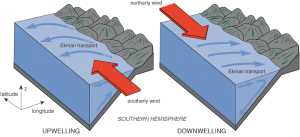
Vortex Shedding
Vortex shedding is another mechanism that can create whirlpools. When a fluid flows past an obstacle, vortices can be generated on either side of the obstacle, creating alternating whirlpools downstream. This process is commonly observed in rivers and can also occur in oceanic currents flowing past underwater structures.
Types of Oceanic Whirlpools
Mesoscale Eddies
Mesoscale eddies are medium-sized and can last from weeks to months. They mainly form due to the interaction of currents and can cover areas of several hundred kilometers. These eddies are crucial for the transport of heat and nutrients in the ocean.
Submesoscale Eddies
Submesoscale eddies are smaller and shorter-lived, often forming and dissipating within days. Their formation is influenced by local processes and can significantly impact the distribution of nutrients and organisms on a small scale.
Permanent Whirlpools
Some whirlpools are relatively permanent, forming in specific locations where conditions are consistently favorable. Examples include the Sargasso Sea gyre in the North Atlantic and the Great Pacific Garbage Patch, where ocean currents converge and create stable, rotating systems.
Temporary Whirlpools
Temporary whirlpools are often the result of transient weather patterns, such as storms or seasonal changes in wind and temperature. These whirlpools can appear and disappear quickly but can still have significant local effects on marine life and nutrient distribution.
Ecological Impact of Oceanic Whirlpools
Nutrient Transport
Whirlpools play a vital role in transporting nutrients across the ocean. By spinning, these whirlpools bring nutrients from the depths to the surface layers, which promotes the growth of phytoplankton and, consequently, feeds the entire marine food chain.
Temporary Habitats
Additionally, whirlpools can create temporary habitats for various marine species. The moving water within a whirlpool can trap and concentrate organisms such as fish, plankton, and other marine life forms, creating zones rich in biodiversity.
Influence on Marine Migration
Whirlpools can also affect the migration patterns of marine animals. For example, some species of fish and marine mammals may use these rotating currents to travel more efficiently, conserving energy as they move with the flow.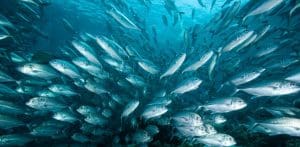
Impact on Human Activities
Oceanic whirlpools can influence human activities such as shipping and fishing. Strong whirlpools can pose hazards to navigation, while nutrient-rich waters can enhance fishing opportunities. Understanding the dynamics of these whirlpools is essential for safe and efficient maritime operations.
Importance for Oceanic Research
Climate Studies
Oceanic whirlpools are of great interest to scientists studying the climate. By influencing the transport of heat and nutrients, these whirlpools can affect large-scale climate patterns. Understanding their formation and behavior is crucial for improving climate models.

Ecosystem Monitoring
Moreover, monitoring whirlpools is essential for managing marine ecosystems. Scientists use satellites and buoys to track these phenomena, allowing them to better understand ocean dynamics and predict changes in marine ecosystems.
Technological Advances
The study of oceanic whirlpools has led to advancements in technology, such as improved satellite imagery and oceanographic instruments. These tools help scientists gather data on water temperature, salinity, and current patterns, providing insights into the behavior and impact of whirlpools.
Predicting Environmental Changes
By studying whirlpools, scientists can better predict changes in the ocean environment, such as shifts in nutrient distribution or the movement of marine species. This knowledge is vital for managing fisheries, protecting marine habitats, and mitigating the impacts of climate change.
Conclusion
In summary, oceanic whirlpools are complex and fascinating phenomena that result from the interaction of multiple factors such as ocean currents, winds, storms, and the Coriolis force. These whirlpools not only affect the transport of nutrients and marine biodiversity but are also crucial for climate research and the monitoring of marine ecosystems. With a better understanding of how these whirlpools form and function, scientists can improve climate models and contribute to ocean conservation.

